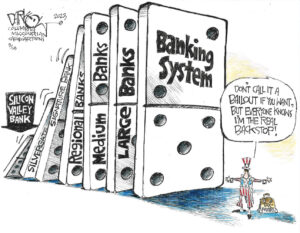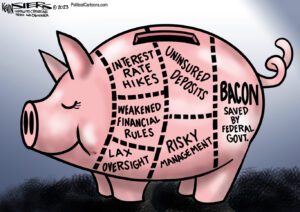The Insider’s Economic Dictionary: B Is for Bailout
Republicans and the financial sector sequester the economic surplus in their own hands, price their economic rents to squeeze incomes, and then criminalize poverty as if the poor vote to be poor as a matter of choice!
By Michael HudsonThis piece first appeared at Michael Hudson’s website.
Read the “A” section of the Insider’s Economic Dictionary here.
Bailout: Reimbursement to speculators and savers of losses incurred by bad loans, investments or deposits in banks that fail. The effect of this moral hazard is to preserve financial control in the hands of the economy’s wealthiest 10 percent, “making them whole” by shifting the loss onto the bottom 90 percent of the population in order to benefit those at the top of the pyramid (see Rentier and Oligarchy).
Balance of payments: Every country has offsetting trade and financial movements. And as in any balance sheet, every country’s payments are in overall balance by definition. The balance of payments is an accounting statement of international credits or inflows such as export receipts, the run-up of debt, and payments to foreigners for imports or to buy foreign companies.
The formal term should be “balance of international transactions,” because many transactions do not involve payments. U.S. foreign aid is extended “in kind” (military hardware, food dumping, etc.) rather than involving dollar payments, while many exports are financed on credit. Retained earnings by foreign branches of U.S. companies are treated as if they flow into the economy and then flow out again, although no flows of payments actually are involved.
This being said, there are many sub-balances that can be struck, most notably the current account (trade, services, and transfer payments such as immigrants’ remittances) and “capital” account (loans and investments). The most typical (im)balance is the rise in foreign indebtedness and loss (or rise) of international reserves. For the United States the “balance” used to consist of gold sales, but today it is the run-up of Treasury debt to foreign central banks (but not to private holders) to settle the imbalances on trade and investment accounts. The difference between the United States and other countries is that it can settle these imbalances in its own fiat currency – U.S. dollars – whereas other countries must depend on the U.S. monopoly of dollar creation to finance their deficits. (See Dollar Hegemony.)
Bankruptcy: For corporations, a means of shedding their long-term commitments to their workers and retirees in order to pay their bondholders and other creditors. For workers, the obligation to lose their property to enable their mortgage lenders and other creditors to collect savings expanding by the laws of compound interest. (See Debt Deflation.)
Blame the Victim: Republicans and the financial sector sequester the economic surplus in their own hands, price their economic rents to squeeze incomes, and then criminalize poverty as if the poor vote to be poor as a matter of choice!
Bond: From the verb meaning “to bind.” The ancient meaning referred to the shackles by which creditors kept their debtors in personal bondage. Since debt bondage and debtors’ prisons have been outlawed, the term has connoted the legal financial shackles by which debtors are bound to pay their creditors, subject to bankruptcy laws designed to alleviate debtor distress. (The term distress originally referred to the debtor’s animal or other collateral pledged to his creditor. Agreement, bargain, compact and contract derive from the Latin Romance roots, reflecting the Norman invasion.)
Government bonds reflect the political choice to refrain from creating public credit. This decision obliges the government to borrow from creditors at interest, and to let commercial banks monetize their own credit to extend to the government. (See Central Bank.)
Bronze Age: During he two thousand years 3200-1200 BC in the Near East – mainly in the Sumerian core (in today’s southern Iraq, 3200-2000) and subsequently the Babylonian core further north – temples and palaces created the first standardized weights and measures, money, prices and interest rates, land rent and salary rates, which spread from these public institutions to the rest of the economy. (See Economist.)
Bronze Age societies were mixed economies. Public institutions leased lands, workshops, beer distribution and other enterprises to private operators, and consigned temple handicrafts (textiles, metal working etc.) to merchants. Rulers in Mesopotamia and its neighbors kept financial dynamics in check by proclaiming Clean Slates that cancelled tax debts and other non-commercial personal debts when they took the throne or as economic or military conditions warranted (see Jubilee Year), especially in the Old Babylonian period (2000-1600 BC).
Bubble: Bubbles can occur in stocks and bonds, real estate or new ventures (such as the U.S. dot.com bubble), but all are financial in origin, and are promoted by governments. They offer a way for governments extricate themselves from public debt by convincing populations to exchange their holdings of government bonds (or most recently, Social Security claims) for stocks in private companies, whose market value is then permitted to collapse, enabling the government to blame the madness of crowds.
Business cycle: Most 19th-century economic studies explained how financial crises bring business upswings down with a crash. Wesley Claire Mitchell at the National Bureau of Economic Research analyzed business “cycles” in terms of a sequential rise and ebb of business, with leading, coincident and lagging “indicators.” This approach depicted the course business as being automatic and self-stabilizing, much like a steady sine-like wave of economic development (which Joseph Schumpeter depicted in his book on Business Cycles).
The major shortcoming of this approach is that crashes occur more rapidly than upswings, and are brought about not simply by rising wages and raw-materials prices as full-capacity operations are reached (see S-Curve), but by the growth of debt and rising interest charges stifling profits and reducing the prices of bonds, stocks and real estate. (See Debt Deflation.) In the face of falling asset prices, the collateral held by banks and other debtors fails to cover their liabilities. This ends in a panic as assets are abruptly liquidated to pay debts falling due or called in. Debt repayment absorbs the income hitherto spent on new direct investment and consumption, so employment and production fall off.
Upcoming: C is for Camouflage
Your support matters…Independent journalism is under threat and overshadowed by heavily funded mainstream media.
You can help level the playing field. Become a member.
Your tax-deductible contribution keeps us digging beneath the headlines to give you thought-provoking, investigative reporting and analysis that unearths what's really happening- without compromise.
Give today to support our courageous, independent journalists.




You need to be a supporter to comment.
There are currently no responses to this article.
Be the first to respond.